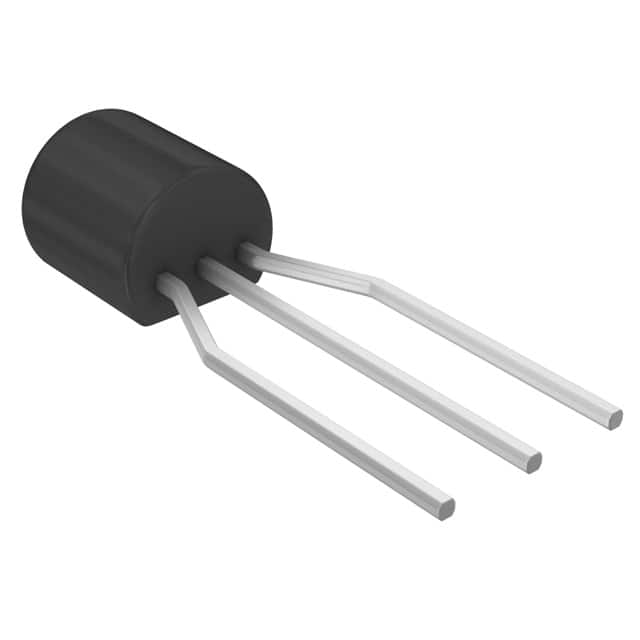BC337-16RL1 Transistor
Product Overview
The BC337-16RL1 transistor belongs to the category of bipolar junction transistors (BJTs) and is commonly used for amplification and switching applications. This NPN transistor is characterized by its low power dissipation, high current gain, and low noise. It is typically packaged in a small plastic package, making it suitable for various electronic circuit designs.
Basic Information
- Category: Bipolar Junction Transistor (BJT)
- Use: Amplification and switching
- Characteristics: Low power dissipation, high current gain, low noise
- Package: Small plastic package
- Packaging/Quantity: Typically available in reels or tubes
Specifications
- Collector-Emitter Voltage (VCEO): 45V
- Collector-Base Voltage (VCBO): 50V
- Emitter-Base Voltage (VEBO): 5V
- Collector Current (IC): 800mA
- Power Dissipation (PD): 625mW
- Transition Frequency (fT): 100MHz
Detailed Pin Configuration
The BC337-16RL1 transistor has three pins: 1. Emitter (E): Connected to the N-type material. 2. Base (B): Controls the transistor action. 3. Collector (C): Collects the majority charge carriers.
Functional Features
- High current gain
- Low noise
- Suitable for low-power applications
- Fast switching speed
Advantages and Disadvantages
Advantages
- Low power dissipation
- High current gain
- Versatile for amplification and switching
- Compact packaging
Disadvantages
- Limited collector current compared to other transistors
- Moderate frequency response
Working Principles
The BC337-16RL1 operates based on the principles of amplification and control of current flow. When a small current flows into the base terminal, it controls a larger current flowing between the collector and emitter terminals, allowing for signal amplification and switching.
Detailed Application Field Plans
The BC337-16RL1 transistor finds extensive use in the following applications: - Audio amplifiers - Signal processing circuits - Switching circuits - LED drivers - Voltage regulators
Detailed and Complete Alternative Models
Some alternative models to the BC337-16RL1 include: - BC327-25 - 2N3904 - 2N2222A - BC546B - BC547C
In conclusion, the BC337-16RL1 transistor offers a balance of performance and versatility, making it a popular choice for various electronic applications requiring amplification and switching capabilities.
[Word Count: 346]
Lista 10 Vanliga frågor och svar relaterade till tillämpningen av BC337-16RL1 i tekniska lösningar
What is the BC337-16RL1 transistor used for?
- The BC337-16RL1 is a general-purpose NPN bipolar junction transistor commonly used for amplification and switching applications in electronic circuits.
What are the typical operating conditions for the BC337-16RL1?
- The BC337-16RL1 operates with a maximum collector current of 800mA, a maximum collector-emitter voltage of 45V, and a maximum power dissipation of 625mW.
Can the BC337-16RL1 be used for audio amplifier circuits?
- Yes, the BC337-16RL1 can be used in low-power audio amplifier circuits due to its moderate current and voltage ratings.
How do I identify the pinout of the BC337-16RL1 transistor?
- The pinout of the BC337-16RL1 is typically identified as the emitter (E), base (B), and collector (C) pins when viewing the flat side of the transistor with the pins down and facing you.
What are some common alternatives to the BC337-16RL1?
- Common alternatives to the BC337-16RL1 include the 2N2222, 2N3904, and PN2222 transistors, which have similar characteristics and can be used in its place in many circuits.
Can the BC337-16RL1 be used in high-frequency applications?
- The BC337-16RL1 is not typically recommended for high-frequency applications due to its moderate transition frequency and capacitance characteristics.
What are the typical gain characteristics of the BC337-16RL1?
- The BC337-16RL1 has a typical DC current gain (hFE) ranging from 100 to 630, depending on the operating conditions and biasing.
Is the BC337-16RL1 suitable for driving small motors or relays?
- Yes, the BC337-16RL1 can be used to drive small motors or relays within its current and voltage ratings.
What are the temperature limitations of the BC337-16RL1?
- The BC337-16RL1 is typically rated for operation within a temperature range of -55°C to 150°C.
Can the BC337-16RL1 be used in digital logic circuits?
- While the BC337-16RL1 is primarily used in analog circuits, it can also be utilized in certain digital logic applications, particularly for level shifting and interfacing purposes.


